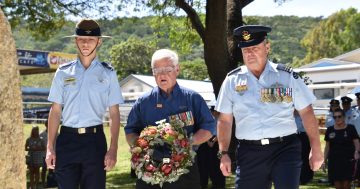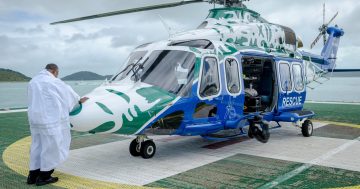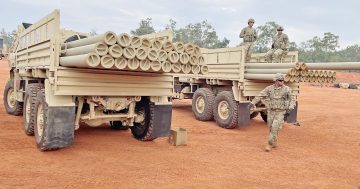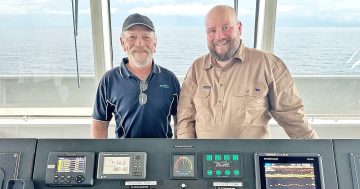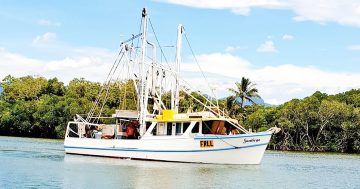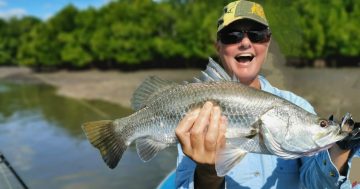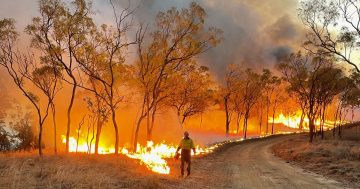
Beaufort bomber Winnie the Pooh being towed northwards along the beach by Mapoon people. Note the heavy wet season sky and waves at the water’s edge. Photo by Frank Cane, courtesy of Lance and Barbara Potter.
It was a typical wet season day 80 years ago, with heavy monsoon clouds and rain squalls rolling over the Mapoon Presbyterian Mission. Suddenly, the village community heard the roar of aircraft engines overhead and their thoughts turned to a possible attack by a Japanese plane! Everyone was conscious of numerous enemy air raids on Horn Island, just to the north. No, this was the welcome sight of a Royal Australian Air Force bomber flying low in search of a landing ground. Historian GEOFF WHARTON tells the story …
CAPE York Peninsula was part of Australia’s front line in 1942-43 when the RAAF flew patrols from the Cape and other Queensland airfields to defend the north from Japanese attack.
Aboriginal people remained at their isolated mission stations on the western Peninsula throughout these dangerous years and directly contributed to the war effort.
Six Mapoon men served in the 23rd Queensland Regiment, Volunteer Defence Corps; four served in the 2nd Australian Water Transport Group, Royal Australian Engineers, five served as un-enlisted crew on the Royal Australian Navy lugger Viking, engaged on rendering mines safe duties; and 14 served in the Civil Constructional Corps constructing and maintaining defence installations at Higginsfield, Horn Island and Iron Range air bases.
Other Mapoon men crewed Presbyterian mission vessels used to resupply several RAAF radar stations along the Gulf coast.
At midday on February 22 1943, a Beaufort Mark VA bomber (A9-157) of No. 7 Squadron, RAAF was on a convoy escort patrol over the Arafura Sea and Gulf of Carpentaria when it ran into the wet season weather and was unable to rendezvous with the convoy north-east of the Wessel Island group.
The aircraft – affectionately named Winnie the Poohand painted in camouflage brown and green on top and light blue underneath – was marked with the 7 Squadron code letters KT and the letter M on the sides of the fuselage.
The nose art painted by Sergeant Bruce Melrose was A.A. Milne’s character Winnie the Pooh carrying a bomb instead of his usual jar of honey.
Its crew, including pilot Sergeant A.R. (Fred) Turner, navigator E. (Ted) Delaney, wireless air gunner H.B. (Bruce) Melrose and wireless air gunner C.J. (Cyril) Hughes, had been called out at 0530 from Horn Island air base to fly the escort task.
7 Squadron was responsible for regular patrols in this area usually flown at an altitude of about 1500 feet and occasionally attacked Japanese submarines and aircraft from the Aru Islands.
On a similar patrol on June 18 1943, Flying Officer Peter Hopton’s crew shot down an enemy navy reconnaissance floatplane, code named ‘Jake’, the first kill by a Beaufort aircraft.

The crew of Winnie the Pooh photographed later in the war after they were commissioned and posted to 32 Squadron, RAAF. From left – Pilot Officer Bruce Melrose, PO Cyril Hughes, PO Ted Delaney and PO Fred Turner. Photo courtesy of the late Bruce Melrose.
Bruce Melrose wrote to his parents soon after the forced-landing near Mapoon and vividly recalled the crew’s anxious search for land as the tropical monsoon rains lashed the Beaufort:
We had our storm windows open and couldn’t see the nose of the kite, and so tossed about were we, that we realized that we didn’t have enough juice [fuel] left to get home….We started pumping out wireless messages as fast as was possible and called for Direction Finding bearings from several ground stations in order that they’d know where to send out the rescue boats….all of a sudden Taffy Delaney gave a lusty cheer and pointed to a piece of coastline showing through the storm….We crossed the coast and almost immediately passed over a group of buildings, which we recognised on our maps as the Marpoon [sic] Mission Station. We then went out to sea again, dropped our bombs and then came in along the beach and plopped Winnie down onto the sand, in a very neat forced landing.
Turner had skilfully landed the aircraft on the beach about eight miles (12.9km) south of the mission and in the area known as Rumu just near Janie Creek.
He fought to keep the heavy aircraft away from the waves crashing onto the narrow beach when a large wave struck ‘the port wheel’ causing the Beaufort to swerve into the sea.
Bruce Melrose recalled that all the loose equipment in the aircraft and removable guns were stacked on the high sand dunes and the secret IFF (Identification Friend or Foe) gear blown up with its in-built detonators.
The bedraggled crew found their way to Mapoon mission where they were assisted by the Aboriginal residents and Presbyterian missionaries, Frank and Ena Cane.
The mission hospitality made a lasting impression on the young RAAF men as Bruce Melrose wrote that they “gave us dry clothes, a hot bath and a beautiful roast dinner, telling us that they had seen us drop our undercarriage and had guessed we were in trouble”.
Horn Island RAAF Base (28 Operational Base Unit, known as 28 OBU) near the tip of Cape York had been alerted and a search and rescue team including skipper Lance Potter, Ron Cook, navigator Bob Manning, medical officer Wishart, forward hand Ned Kelly, crewman Eric Hicks and wireless operator Jack Woodward on RAAF crash launch 08-11 set off that afternoon to locate the Beaufort aircrew.

PO Eric Kirk and Mapoon men guiding the aircraft with improvised handles. The tail section had been removed and roped onto the wings. Photo by Frank Cane, courtesy of Lance and Barbara Potter.
They were accompanied by Pilot Officer Eric Kirk of RAAF 12 Repair and Salvage Unit (12 RSU).
12 RSU had been formed at Charters Towers in May 1942 and had established a Salvage Party at Horn Island the following September.
Jack Woodward recalled a rough trip down the Gulf coast pounded by waves from a brisk southerly wind and Lance Potter wrote in his diary that once the boat was able to run with the sea it would shoot 300 yards on the big waves and schools “of fish are met every little while. Skipjack, bonito and mackerel. Sea snakes 6ft. long and very thick are seen and strange bird life”.
Next morning, the crash launch anchored in Port Musgrave and the Beaufort crew was found in the safe hands of the Mapoon mission.
Pilot Officer Kirk was instructed to retrieve the aircraft if possible, so he sought the assistance of the mission.
Frank Cane suggested that “Winnie” could be towed by the Aboriginal residents and this was enthusiastically supported by the community.
A summary report by 12 RSU’s commanding officer, Squadron Leader T.A. Cummin described the operation:
The aircraft was manhandled out of the water and later towed eight miles to the Mission, with the aid of five horses and some 150 Mission personnel. The two Mission luggers were placed at the disposal of the rescue party, and after dismantling the component parts were despatched to HORN ISLAND in the two luggers. The report concludes – “It cannot be too strongly stressed that without the assistance which was made available on the spot, when the aircraft was in the water, it would have been a complete write-off”.
The rescue was a magnificent community effort when it is understood that a Beaufort bomber weighed up to 21,500 lbs (approximately 9.5 tonnes) and it had to be towed along the beach for over 12 kilometres.
This event was remembered with great fondness by the people of Mapoon such as the late Annie Mamoose who wrote in 1988 how ropes “were tied from the plane to horses and we helped the horses pull the plane”.
“Alfie, Jerry Hudson and Benny Charger handled the horses. It took us 3 to 4 days pulling the plane on the beach at low water. We had 3 cooks to feed all of us, Suzie Madua, Rosie Reid and Victoria Luff.”
Another former Mapoon resident, the late Ralph Woodley, recalled: “We pulled it from there right up half-way the first day, the next day (to) Cullen Point….We get him on the low tide, the beach is all hard….We run a long rope with some horse(s) and we pulled the plane – all boys and girls, men and women”.

LAC Lance Potter, Marine Section, 28 OBU, RAAF.
Young Lance Potter recorded in his diary how the salvage crew “rigged a pair of shafts to steer with” because the tail wheel was damaged.
Despite the improvised steering, about three kilometres were travelled before the towing team was exhausted. Lance continues the story:
Next day our pulling force increased, we set to the task in earnest. Even a blind man called Frank lent a hand. Frank Cane lent me his whistle and so we gathered 50 women and big girls 40 men and boys, 4 horses pulling only from their saddles. At a blast from the whistle the plane began to move and we found it was good going. I moved up and down the ropes offering encouragement and urging them to sing and so we put the miles behind us.
Lots of small children followed along and all was calm and bright. We got stuck a couple of times but after a spell moved off again. We stopped for tea and cigarettes, the non-smokers were given sweets. In the course of the haul we had to cross two creeks about 16 yards wide and 9” deep.
We gathered pace and took the creeks in our stride….We were now nearing the point (Cullen Point) and all were happy with enough energy left to sing. A short spell and then the final pull up on to the high sand. The big rope broke, 30 girls and 20 men went down in a heap. I fell on a girl called Bessie. She blushed but laughed.
Now “Winnie’ rested on the flat ground where it can be taken to pieces. We have beaten the soft sand, the rollers, the surges, the quick sand, soakage and the creeks, dodged huge logs and generally done a magnificent job.
The dismantling programme took three weeks, with two shipments on the mission lugger J.G. Ward and the final load on the Morning Star.

Beaufort A9-157, code KT-M, Winnie the Pooh being manoeuvred by Mapoon people at Rumu. Photo taken by Frank Cane and provided courtesy of Lance and Barbara Potter.
Life at Mapoon was an attractive adventure to Lance as he recorded activities such as communal singing and the beauty of the natural bush:
By 8 p.m. folk are assembled and seated, about 150 are there. The fire is lit and the buckets put on. We sit on the back balcony and the singing begins.
Hymns are their choice and many favourites are given in sweet clear voices. The women sing in 2 parts and the men fill in the bass.
Among the best is ‘Father we thank thee’ a beautiful number….Frank and I go riding….Jubilee is to be our guide…After a while it rains, but we kept going in and out of the dense scrub, thick with undergrowth, lawyer vine and pandanus and the various tropical creepers. Wildflowers look up at us at every step.
At last, after weeks of toil and improvisation, the Aboriginal men of Mapoon assisted the RAAF team to load the Morning Starand it was time for the generous farewells of the Mapoon people:
We came to Mapoon in shorts, we leave with 4 bags of coconuts and box of dried coconut. I have 50 fans 50 strings of beads and a complete tortoise shell.
The presents from Mabel. 1 large box and 1 kerosene tin of shells, 2 boomerangs and 7 woomeras, 5 spears, 3 yams and some pumpkins….
I take a long last look at our home of the past month, we are on “Star”, up anchor, sail set and we begin on a short outward tack so as to be able to clear the point….Mirrors are flashing, they sparkle like diamonds in the bright sunlight.
Post-war recollections suggested that “Winnie” was re-assembled and flew over the mission with the words “Mapoon” painted under its wings, although it is more likely that this was Beaufort A9-140.
The squadron’s unit history sheet A.51 recorded that Beaufort A9-140 was flown from Horn Island to Ross River base (at Townsville) by Fred Turner on February 28.
Bruce Melrose wrote that his crew flew via Mapoon and dropped gifts to the community that day.
There is some uncertainty whether or not Beaufort A9-157 was converted to spare parts or if it flew again: an article in Wingsmagazine published in February 1944 reported “today this Beaufort flies again”, but the official records show that “Winnie” was converted to components, presumably for use as spare parts for other aircraft.
In a letter of appreciation to the Presbyterian Church of Queensland, the Air Officer Commanding North Eastern Area, Air Commodore A.H. (Harry) Cobby DSO, DFC, wrote that the mission’s actions made it possible for the RAAF to salvage “a valuable aircraft which, had it not been for his [the missionary’s] assistance, would have been completely lost”.
The people of Mapoon had not only saved Winnie the Pooh but had shown the young men of the RAAF a generosity of spirit which would remain an example to these veterans all their lives.
Community interest in the story led to other exciting developments in the late 1990s.
Brisbane Indigenous Media radio station 4AAA produced a poster and CD focusing on Mapoon’s history entitled The Moving of Winnie. Bruce Melrose reproduced the artwork to go with the poster.
Encouraged by principal Letitia Murgha, Mapoon Elders visited the Mapoon Campus with Frank Cane’s photographs and told the story to a new generation.
Led by choreographer Rhonda Parry, the children developed a dance routine about the rescue which they performed at the 1999 Croc Eisteddfod at Weipa.
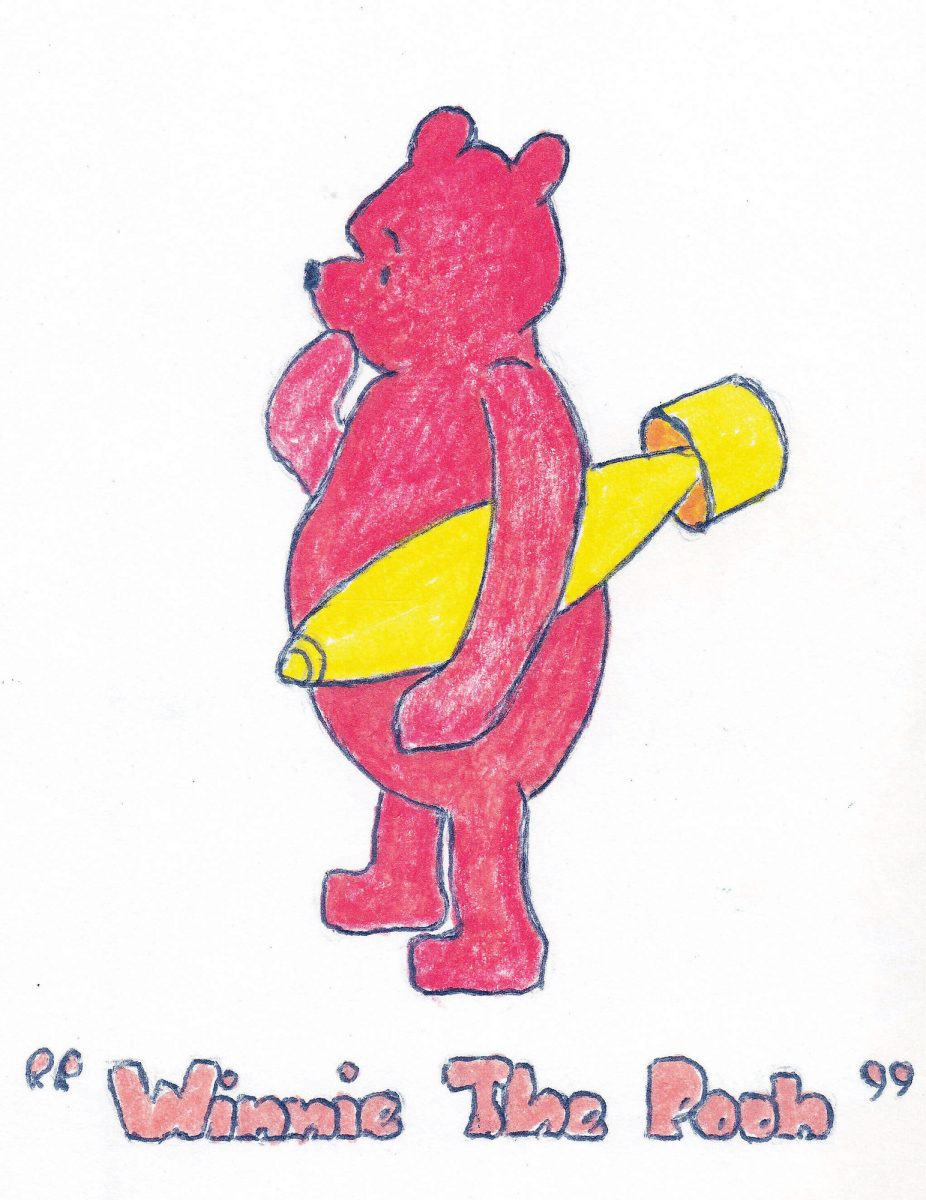
Reproduction of the nose art by Wireless Air Gunner Sergeant Bruce Melrose.
AUTHOR ACKNOWLEDGEMENTS
GEOFF Wharton was first told the Beaufort story by the late Ralph Woodley in 1988 and Suzie Madua of Mapoon in 1995.
Their enthusiasm for the story and subsequent help from ex-RAAF veterans involved in the incident encouraged the author to research the full account of this remarkable wartime rescue.
Thanks are extended to the following people who provided information or assisted in other ways:
People of Mapoon, including: the late Elders Joyce Charger OAM, John Cockatoo, Connie Cooktown, Ina Hudson, Suzie Madua, Margaret Nota, William Parry, Bessie Savo, Tim Savo and Ralph Woodley; former RAAF veterans: Norman Ashworth, Leigh Brownrigg, Keith Furze, Ted Leslie, Bruce Melrose, Lance Potter and his wife Barbara, Hugh Roche (No. 7 Squadron Association), Jack Woodward, P.A. Gibb; Jean Little OAM and Ian Little; Cheryl McNamara, National Archives of Australia, Brisbane; Janet Beck and David Wilson, RAAF Historical Section, Canberra; Dennis Hornsey, former Editor, Wings (RAAF Association); the late Joan Pigram and the late John Sinclair, Queensland Presbyterian Historical Records; Isobel Savo, Don Egan and Kate Head; songwriter Ken McDonald; Letitia Murgha and Rhonda Parry.


